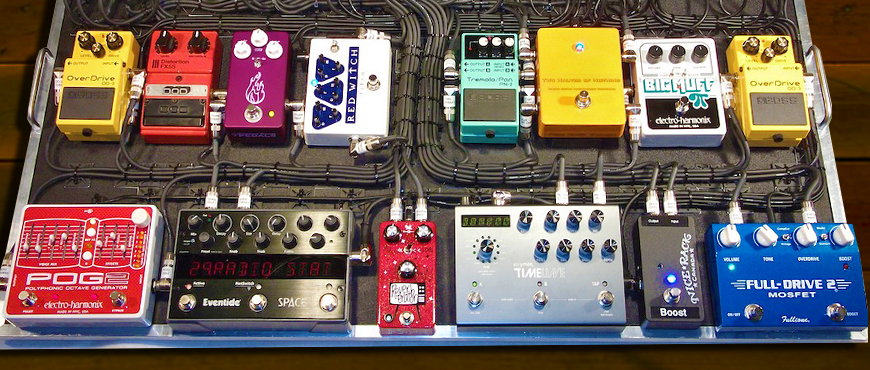One of the coolest advantages to playing an electric guitar is the ability to incorporate different effects into your sound.
Some effects are subtle while other can render the guitar unrecognizable.
Effects are available as stomp boxes, 19 inch rack mount units or built right into amplifiers.
They are most often placed into the Signal Path between the guitar and the amplifier, though some amps let you place effects after the amp’s electronics but before the speaker(s) in an Effects Loop.
[two_fifth_last padding=”0 20px 0 20px”]
Types of effects include:
- Distortion
- Dynamics
- Filter
- Modulation
- Frequency
- Time-based
[/two_fifth_last]
Guitar Effect Descriptions:
Preamp – The preamp pedal is a Dynamic effect which means it modifies the volume of an instrument. They usually come at the beginning of the effects chain and are used to boost the volume for solos. Envelope Filter (Auto Wah) – Filter effects boost or weaken specific frequency regions of the guitar signal. Envelope filters have a similar sound to wah pedals, however they are activated by volume (the hardness of picking attack) rather than a foot pedal. Because of this they should be placed before any compressors in the effects chain.
Octaver – An octave pedal in a Pitch effect that doubles the note being played an octave up or one to two octaves down. Pitch devices should go near the front of the signal path so all effects that come after will alter the new pitch as well as the original.[/one_third_last]
Pitch Shifter – A pitch shifter is similar to the ocataver but instead of only being able to double notes at the octave it can double the original note at any interval you like to create a harmony. There are also models that allow the original pitch to be raised and lowered similar to the whammy bar on a guitar.
Compressor – Compressors fall into the Dynamic effect category because they affect the volume of the signal path. They make quite sounds louder and loud sounds quieter compressing the dynamic range of the sound. Compressors should be placed near the beginning of the effects chain.
Distortion – Distortion, overdrive, gain, and fuzz pedals create a warm, gritty sound by clipping the guitar’s audio signal and adding overtones. Distortion and fuzz effects produce the same amount of distortion at any volume while overdrive and gain effects are produce “clean” sounds at quieter volumes and distorted sounds at louder volumes mimicking the effect of a tube amp.[/one_third_last]
Wah Pedal – The Wah pedal is a filter effect that produces a vowel like sound by altering the frequency spectrum of an instruments signal. As a “gas pedal” type foot pedal is tilted a volume boost sweeps through the frequency range. Wah pedals can be placed before or after distortion effects to create different results.
Modulation Effects – There are many types of Modulation effects including: Chorus, Flanger, Phaser, Ring Modulator, Tremolo, and Vibrato. They split an instruments signal into two parts then mix an unaltered signal with one that has been modified in various ways according to the type of effect being applied.
Delay – Delay is a Time-Based effect that sends a duplicate version of the instrument signal to the amp with an adjustable time delay creating the illusion of an echo. Time based effects should be placed near the end of the signal path for the most natural sounding results.[/one_third_last]
Equalizer – An equalizer (EQ) is a filter effect that lets you boost or cut specific frequency regions of a signal. This can be used to remove unwanted noise, to make an instrument more prominent in the mix, or alter it’s tone. EQs can be placed nearly anywhere in the chain with varying results.
Noise Gate – A noise gate is a dynamic effect that removes unwanted hiss and hum from the signal path. It basically shuts off the signal when the volume drops below a set threshold. It closes the gate and doesn’t let anything through unless it is loud enough. Gates should be placed near the end of the effects chain but can appear before or after the reverb for different effect.
Volume Pedal – Another dynamic effect is the volume pedal which would be placed near the end of the effects chain. Most models offer a minimum volume setting for the effect. In the heel down position volume would be set to this user defined lower setting, in the toe down position it would return to full volume.[/one_third_last]
Reverb – Reverb is a time-based effect that creates a large number of echoes that decay over time. Unlike the well-defined echoes from a delay pedal the reverb produces echoes which are blurred together creating a “wash” of sound. For the most natural sounding result reverbs should be placed at the very end of the effects chain.
The Typical Order of Effects
Experimentation is encouraged.
